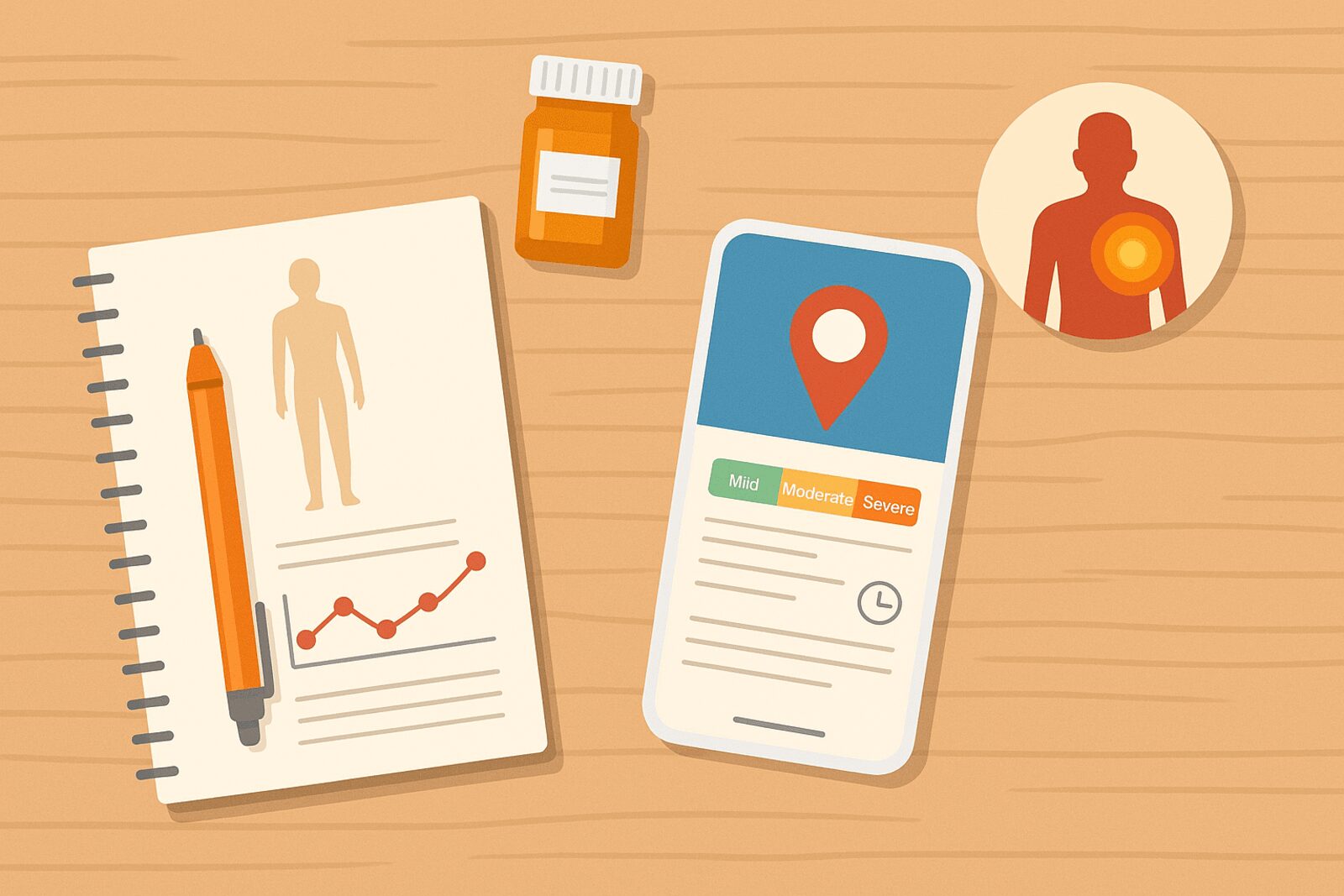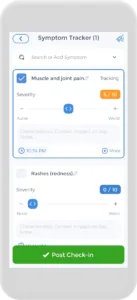
Over 51 million adults in the US live with chronic pain, yet most never track it.
Without a daily pain journal, it is nearly impossible to understand what triggers flare-ups, whether treatments are working, or how symptoms evolve over time. Research shows that tracking pain can increase treatment success by over 30 percent and reduce avoidable prescriptions.
A pain journal gives you real data about your pain, not just guesses. In the next few minutes, you will learn how to log pain symptoms the right way, spot patterns most people miss, and finally create a health record that doctors take seriously.[1][2]
How to Use a Pain Journal or Pain Tracker Effectively
A pain diary is an excellent tool for anyone living with chronic pain. It is a way to track and take pain medicine and document your pain symptoms and other relevant details. Such as sleep, diet, and exercise. Keeping a pain journal can help you better understand your pain. And work with your doctor or health professionals to develop an effective pain relief plan.
A pain diary can be in an electronic diary or paper format. It should be updated regularly with specific and detailed descriptions of your pain, including the location, intensity, and duration of your pain. You should also note any triggers that seem to make your pain better or your pain worse. Such as physical activity or certain foods. By identifying patterns and triggers, you can work with your healthcare providers to develop a personalized pain management plan that addresses your specific needs and concerns.
Benefits of Using a Daily Pain Log
- Identification of patterns and triggers is a crucial aspect of managing chronic pain. By recognizing these patterns, patients can better understand what factors contribute to their pain (making it better or worse) and take steps to avoid or mitigate them. This can include adjusting their daily routine, changing their diet or exercise habits, or seeking out specific treatments.
- Improved communication with healthcare providers is another important factor in managing chronic pain. Patients who can communicate clearly and effectively with their healthcare providers are more likely to receive appropriate care and achieve better treatment outcomes. This can involve asking questions, expressing concerns, and working collaboratively with providers to develop a comprehensive treatment plan.
- A better understanding of pain and its impact on daily life is also essential for effective pain management. This includes not only the physical sensations of pain, but also the emotional and psychological effects that chronic pain can have on a person’s quality of life. Patients who are able to recognize and cope with these effects may be better equipped to manage their pain and maintain a positive outlook.
- Finally, improved treatment outcomes are a key goal of chronic pain management. This can involve a variety of approaches, including medication, physical therapy, and alternative therapies such as acupuncture or massage. By working with healthcare providers to develop a personalized treatment plan, patients can achieve better pain relief and overall health outcomes.
Expert Tips for Filling Out Your Pain Journal
- When deciding whether to use an electronic or paper format for your pain diary, consider factors such as accessibility, ease of use, and personal preference. Whichever format you choose, make sure it is easily accessible and convenient for you to use daily.
- It is important to make time every day to record pain symptoms and other relevant details in your pain diary. By doing this, you can better understand patterns and triggers of pain. Which can help you manage your symptoms more effectively.
- When describing your pain, provide as much detail as possible. This includes the location of the pain, the type of pain (e.g. sharp, dull, throbbing). And any other sensations you may be experiencing (e.g. tingling, numbness). Additionally, describe the intensity of the pain and how it affects your daily activities.
- Along with pain symptoms, it is important to record information about your sleep, diet, and exercise. This can help identify patterns and triggers that may be contributing to your pain.
- Note any changes in medication or treatment in your pain diary. This includes any new medications or dosage changes, as well as any alternative therapies or treatments you may be trying.
- To better quantify pain levels, consider using a pain scale in your pain diary. This can help you track changes in pain over time. Provide a more accurate description of your symptoms to your healthcare provider.
- Finally, it is important to keep your pain journal organized and up-to-date. This includes regularly reviewing and updating your entries, as well as keeping any relevant medical records or test results in a safe and accessible location.
What to Track in Your Pain Journal
When keeping a pain diary, it’s essential to record specific details about your pain symptoms. This includes the location, intensity, and duration of your pain. As well as any triggers that seem to make your pain either better or worse. Such as physical activity or certain foods. By identifying patterns and triggers, you can work with your healthcare providers. To develop a personalized pain management plan that addresses your specific needs and concerns.
In addition to pain symptoms, it’s important to record other relevant details in your pain diary or journal, such as your sleep, diet, and exercise. This can help identify patterns and triggers that may be contributing to your pain. You should also note any changes in medication or treatment, including any new medications or dosage changes. As well as any alternative therapies or treatments you may be trying.
To better quantify pain levels, consider using a pain scale in your pain diary. This scale can help you track changes in pain intensity over time. Provide a more accurate description of your symptoms to your healthcare provider.
By keeping your pain diary organized and up-to-date, you can provide your healthcare providers with the information and data they need to develop an effective pain management plan. So start your pain log today, and take control of your pain management journey![3][4][5][6][7][8][9][10]
Downloadable Pain Tracker Templates: Printables, PDFs, Notion, Excel
If you are looking for a pain tracker you can download and start using immediately, we’ve listed several formats below. These templates work well for tracking chronic pain, migraines, joint pain, back pain, and more.
Popular Template Formats:
- Printable Pain Tracker (PDF format) – Simple daily log sheet with space for pain location, severity, duration, and notes. [Download free pain tracker PDF]
- Excel Pain Tracker Spreadsheet – Fully editable tracker with automatic pain level graphs. Good for data analysis. [Get the Pain Log Excel template]
- Google Sheets Version – Same as Excel, but accessible online. Make your own copy instantly. [Copy Google Sheets pain tracker]
- Notion Pain Tracker Template – Log your pain entries inside your Notion dashboard with filters and tag support. Import the Excel file directly into Notion.
- Bullet Journal Layout (BuJo) – Visual tracker ideas you can recreate in your paper journal. Includes pain scale and symptom codes. [View BuJo layout examples]
Each version helps you track pain more consistently and spot patterns. Templates are helpful for those who prefer offline tracking or want a printable sheet to bring to doctor appointments.
If you would rather track everything from your phone, the CareClinic app lets you do all of this digitally, with reminders, pain charts, and a full pain log export feature in PDF format. This way, you can start on paper and upgrade to an app when you are ready.[11]
Pain Tracker Apps: What to Look For
Not all pain tracker apps are created equal. If you are managing daily pain, using the right app can be the difference between guessing and actually improving. Whether you are tracking symptoms for migraines, fibromyalgia, back pain, or endometriosis, your app should make the process easier, not more complicated.
Here are the key features to look for in a pain tracker app:
- Daily symptom logging. The app should let you quickly record pain location, intensity, duration, and triggers.
- Custom fields. Whether you are tracking nerve pain, menstrual pain, or joint stiffness, customization is key.
- Medication tracking. Track doses, set reminders, and log how well each treatment is working.
- Visual reports. Charts, timelines, or graphs that reveal pain patterns over days or weeks.
- Multi-condition support. Useful for tracking overlapping conditions like arthritis and migraines.
- Doctor-ready exports. Look for clean PDF or digital reports that can be reviewed by a physician.
- Cross-platform access. The best apps work on iOS, Android, and may sync with Apple Health or Fitbit.
If you are looking for the best pain tracker app, focus on apps that go beyond basic symptom logging. The goal is to reveal patterns, improve communication with your care team, and make better decisions. CareClinic meets all these needs in one complete platform.[12]
Pain Tracking for Specific Conditions
Pain is not the same for everyone. A migraine has different tracking needs than joint pain or menstrual cramps. That is why the best pain journal is flexible and adapts to your specific condition.
Here is how pain tracking can look for different diagnoses:
- Back pain tracker – Log posture, mobility, sleep quality, and pain levels throughout the day. Ideal for disc issues or sciatica.
- Endometriosis pain tracker – Track pelvic pain by cycle day, pain during sex, fatigue, and gastrointestinal symptoms.
- Fibromyalgia pain tracker – Record widespread pain areas, stiffness, mood, sleep quality, and possible triggers like weather or stress.
- Migraine tracker – Log aura symptoms, location, light sensitivity, medications taken, and how long each attack lasts.
- Joint pain tracker – Track swelling, movement, stiffness after rest, and pain after activity. Useful for arthritis or injury recovery.
- Chest pain tracker – Note severity, context (such as stress or exertion), duration, and associated symptoms like dizziness.
- Abdominal pain tracker – For GI issues, track pain location, bowel habits, meals, stress levels, and nausea.
CareClinic allows you to customize your entries based on these needs and more.
Different mental health conditions need their own tracking approach too. People with bipolar disorder can use bipolar mood diary examples to track their highs and lows over time. This helps spot triggers and patterns that might not be obvious day to day.
Whether your pain is caused by a single condition or a combination, having structured data helps you and your doctor identify trends and improve your care plan.
Understanding Pain: Why You Need a Pain Tracker
Definition of Pain, and Why Does It Matter?
Pain is not just a physical sensation. It is a sensory and emotional experience that often has no visible cause. This is especially true for people with chronic pain, where discomfort continues long after an injury heals, or even when no injury ever happened.
Medical experts now define pain as “an unpleasant sensory and emotional experience associated with, or resembling that associated with, actual or potential tissue damage.” This broader definition validates what millions of people feel every day. Their pain is real, even when tests show nothing wrong.
This matters because chronic pain is often misunderstood or dismissed. If you track your pain, you are not just recording symptoms. You are building a health record that helps you get taken seriously, make better treatment choices, and spot patterns you might otherwise miss.
The Physiology of Pain
The complicated sensation of pain is brought on by the nociceptors, which are specialized sensory receptors. These receptors are present on primary afferent nociceptive neurons’ free nerve terminals, which are located in the skin, muscles, and viscera. When these nociceptors are activated, they produce electrical impulses that are passed along to the brain via the spinal cord and are then recognized as pain.
Numerous stimuli, including mechanical pressure, extremes in temperature, and chemical irritants, can cause nociceptors to become active. Once triggered, they exude neuropeptides that aid in the inflammatory response and nociceptors’ sensitization. Due to this sensitization, the threshold for activation is lowered, which can result in the emergence of allodynia and hyperalgesia (enhanced sensitivity to painful stimuli).
While mechanical nociceptors react to mechanical stimuli, thermal nociceptors are activated by temperature extremes. Numerous stimuli, including heat, chemicals, and mechanical pressure, cause polymodal nociceptors to respond. The activation of nociceptors sets off a series of actions that ultimately result in a sense of pain.
Types of Pain
There are many different types of pain. Some of the most common types of pain are listed below:
- Nociceptive pain: This type of pain is what was discussed in the previous section, where receptors are activated in response to some stimuli. This can include neck pain, musculoskeletal pain, and other common types of pain.
- Neuropathic pain: A complex and often chronic condition that arises from damage to the nervous system. Neuropathic pain feels like shooting, burning, or sharp pain, tingling or numbness, and sensitivity to touch
- Psychogenic pain: A type of pain that is caused by psychological factors and can manifest in different ways. Some people may experience psychogenic pain as a result of a past traumatic experience, while others may develop it due to ongoing stress or anxiety. Psychogenic pain can be difficult to diagnose and treat because it is often accompanied by psychological symptoms and psychosocial risk factors.
Acute versus Chronic Pain
Pain can also be classified as acute or chronic. Acute pain is typically of short duration and is frequently the result of an accident or tissue damage. A sprained ankle, a cut, or a shattered bone are all examples of acute discomfort. Chronic pain, on the other hand, lasts longer, typically more than three months. A multitude of things can contribute to it, including an underlying medical condition, nerve injury, or inflammation. Many people suffer from chronic knee discomfort. Chronic pain, in addition to physical discomfort, can have a substantial influence on a person’s quality of life. As a result, it is critical to effectively both manage pain and treat a chronic pain patient to improve the patient’s overall well-being.
Pain Management
Effective pain management is a crucial part of healthcare because it can assist those who suffer from chronic pain enhance their quality of life and avoid being permanently disabled. Numerous more methods of pain treatment may be helpful in addition to medicine, physical therapy, and alternative therapies like acupuncture. For instance, some people benefit from cognitive-behavioral therapy, while others may gain from making lifestyle adjustments like exercising and other stress-reduction tactics. Working closely with a healthcare professional is essential to creating a complete pain management strategy that takes into account all of your unique requirements, including physical, emotional, and psychological ones. Individuals can enhance their general health and well-being and enjoy a higher quality of life by using a holistic approach to pain management.[13][14]
Best Pain Tracker App for Logging Pain, Symptoms, and Meds
Tracking your pain daily can completely change how you manage your health, and the CareClinic app helps you do it easily. Log your symptoms, medications, triggers, and more in one place. The app turns your data into clear charts and PDF reports that you can bring to your doctor.
If you deal with migraines, joint pain, or chronic conditions, CareClinic helps you spot patterns, stay on top of your treatment, and make better decisions faster. You can also set medication reminders, track progress over time, and stop guessing what is working.
⬇️ Download the CareClinic App now on the Apple App Store or Google Play. Start turning your health data into real results.
Sources
- https://www.ninds.nih.gov/health-information/disorders/pain
- https://painbc.ca/health-professionals/education/OT-workshop
- https://austinpaindoctor.com/your-pain-care-plan-to-occupational-pain-management
References
- “Chronic Pain Among Adults — United States, 2019–2021 | MMWR”. https://www.cdc.gov/mmwr/volumes/72/wr/mm7215a1.htm/
- “2024 Chronic Pain Fact Sheet – Sources – U.S. Pain Foundation”. https://uspainfoundation.org/cpfactsheet24/
- “Using a Pain Diary”. https://www.news-medical.net/health/Using-a-Pain-Diary.aspx
- “Learning About a Pain Diary | Kaiser Permanente”. https://healthy.kaiserpermanente.org/health-wellness/health-encyclopedia/he.Learning-About-a-Pain-Diary.abk1346
- “The Surprising Benefits of Keeping a Pain Journal – PainPathways Magazine”. https://painpathways.org/the-surprising-benefits-of-keeping-a-pain-journal/
- “Pain Diary: How Tracking Can Help in Treatment”. https://www.painclinicbmjh.com/post/pain-diary-how-tracking-can-help-in-treatment
- “Tips For Creating a Pain Journal – Advanced Pain Institute | DFW Pain Management Doctors”. https://apitexas.com/news/tips-for-creating-a-pain-journal/
- “USE OF A PAIN DIARY IN PAIN MANAGEMENT – Michigan Pain Consultants”. https://michiganpain.com/use-of-a-pain-diary-in-pain-management/
- “How to Use a Pain Diary – The National Vulvodynia Association”. https://www.nva.org/learnpatient/how-to-use-a-pain-diary/
- “7 Key Ways A Pain Diary Can Help Arthritis – FlexSEQ”. https://flexiseq.com/blogs/expert-advice/7-key-ways-a-pain-diary-can-help-arthritis/
- “Tracker, Reminder – CareClinic on the App Store”. https://apps.apple.com/us/app/tracker-reminder-careclinic/id1455648231
- “Chronic Pain Management Apps: The Best Digital Health Tools for Relief – Ree Writes – African American female UX writer, health writer, and technical writer in Hampton Roads”. https://dareewrites.com/chronic-pain-management-apps-the-best-digital-health-tools-for-relief/
- “IASP Announces Revised Definition of Pain – International Association for the Study of Pain (IASP)”. https://www.iasp-pain.org/publications/iasp-news/iasp-announces-revised-definition-of-pain/
- “Pain Management Center – Chapter 1 – International Association for the Study of Pain (IASP)”. https://www.iasp-pain.org/resources/toolkits/pain-management-center/chapter1/
- “Symptom & Mood Tracker – Apps on Google Play”. https://play.google.com/store/apps/details



